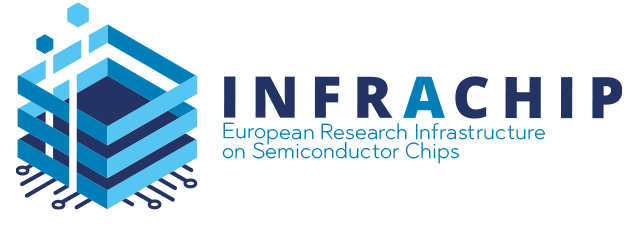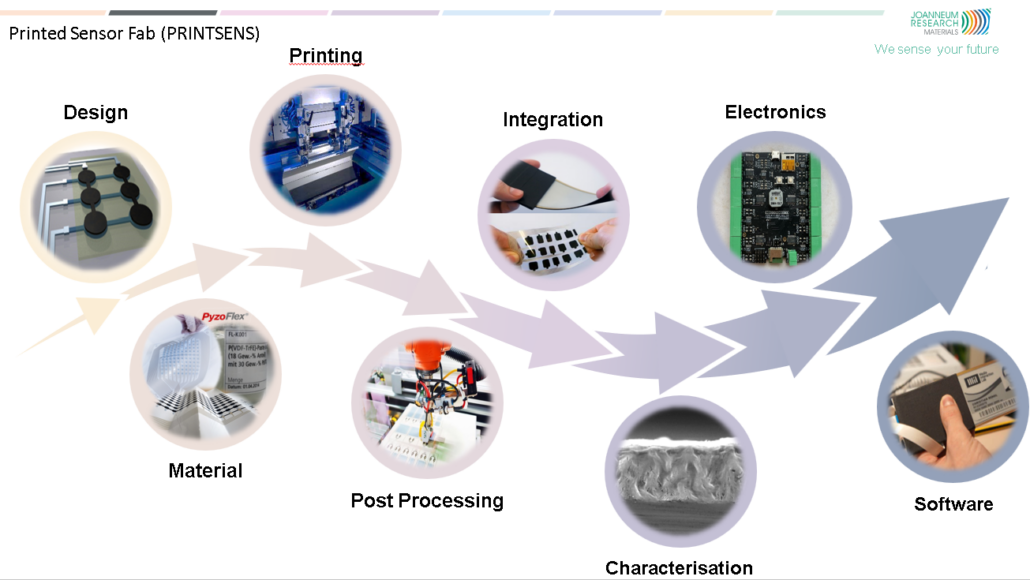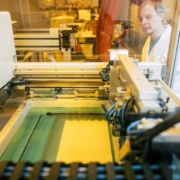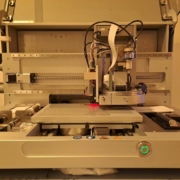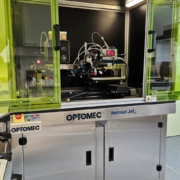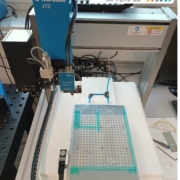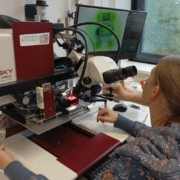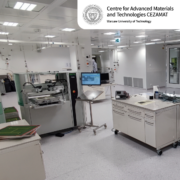Printed Sensor Fab (PRINTSENS)
About
PRINTSENS covers the whole development chain for printed sensors - design & specification - material selection & development - printing - post processing - characterization & functional testing - integration in complex environments - electronics development - software for data read out, collection and visualization
Description
PRINTSENS is made up of six modules, which are accessible either individually or as a complete process flow. It allows to (i) print piezoelectric (vibration, strain, force/pressure), pyroelectric, resistive, magnetoelectric, humidity & temperature senors on versatile, often flexible, substrates for integration in and on 3D objects and (ii) to realize full sensor systems by combining the printed sensors with tailored electronics and software.
Together with the user and targeted to the desired sensor functionality we
– discuss the target specifications and functionality of the printed sensors or sensor systems (Module Design)
– make the layout of printed sensors or design full sensor systems (Module Design)
– select the substrates like polymer films, paper, metal, glass, flex PCBs (Module Material)
– adapt functional inks provided by the user or chose from commercial inks (conductive, sensitive, passivating), proprietary inks (piezo- & pyroelectric = PyzoInk, magnetoelectric, self-reducing Ag & Cu) (Module Material)
– print the selected design by either Screen Printing (2D), Inkjet Printing (2D), Multimaterial Inkjet Printing (2D-3D), Aersosol Jet Printing (2D-3D) or Micro-Dispensing (2D) or a combination of those on substrates in single or multilayers (Module Printing)
– perform the necessary post-processing steps of the printed layers by drying/curing (thermal, UV, IR), thermal annealing, sintering (photonic, thermal). Electrical Hysteresis Poling of piezoelectric layers and Laser cutting/trimming is also possible (Module Post Processing)
– transfer printed sensor (films) on application relevant target substrates (e.g. textiles, leather, wood,…) by transfer printing, hot pressing, lamination & gluing (Module Integration)
– assemble conventional electronic devices together with sensor (chips, discrete components) for ready to go application by conductive adhesives or soldering (Module Integration)
– characterize printed layers by SEM, AFM, surface profiler, tensile tester (Module Characterization)
– functionality testing of fabricated sensors by means of parameter analyser, sheet resistance probe station, piezoelectric & pyroelectric test stands, magnetoelectric test stand, impedance spectroscopy, climate chamber (Module Characterization)
– reliability testing in climate chamber, tensile tester, vibration shaker, … (Module Characterization)
– develop and assemble electronic hardware for current-voltage conversion, AD conversion, amplification (charge, transimpedance), wireless data transmission (BLE, NFC) to realize full sensor systems (Module Electronics)
– develop firmware for data read out, data collection and application software (Module Software)
Technical specifications:
1. DESIGN
AutoCad, SolidWorks
2. PRINTING
Screen Printing: Thieme Lab 1000
Inkjet: PIXDRO LP50
Aerosol Jet: Optomec
Micro Dispensing / picoJetting: Nordson
3. POST PROCESSING
Drying and Sintering: ovens, IR, UV and laser options are available
Poling (DC and hysteresis) for piezoelectric sensors at defined temperature (RT- 250°C)
Laser cutter with CO2 and fibre sources
4. CHARACTERIZATION:
Conductivity/Sheet resistance by 4-Point prober
Parameter analyzer
Piezoelectric testing: Piezometer, Heavy Stamp, Shaker (DEWESoft), Tensile tester (Instron)
Pyroelectric and temperature testing by Linkam Stage
Impedance Spectroscopy setups by Hioki or Novocontrol
Climate chambers
Structural characterization: Atomic force microscopy, Scanning electron Microscopy, Microtom, Laser scanning microscope
5. INTEGRATION:
HotPress
Diebonder Tresky T-3000-Pro and Pick&Place
6. ELECTRONICS:
Altium designer and PCB layouting, charge amplifier, transimpedance amplifier, Dewesoft DAQ, development boards: Raspberry Pi, …
Related technology:
Case study:
A user wants a piezoelectric PVDF-TrFE sensor based on Joanneum’s PyzoFlex technology integrated on a textile substrate as a human machine interface. Before the start of the project, we discuss with the user the target specifications and functionalities (1 on/off button and 1 slider to dim a LED already integrated on the textile), the design (3×10 cm long, to be integrated in an armrest) and the target material properties (slightly stretchable, integrated underneath surface). We choose a suitable existing PyzoFlex HMI design, or design a new one, if necessary, and order respective screens. The user provides the substrate (the textile) and together we screen print the transducers (1 for button, 4-5 for slider) on a stretchable transfer substrate like TPU. Afterwards drying in the belt oven, hysteresis poling is performed to several kV to preferentially align the dipoles PVDF-TrFE. The poling step also constitutes a testing of the fabrication yield of the printed transducers. Finally, we transfer the transducers/TPU onto the target textile by hot pressing. The functionality is then tested in our piezoelectric test stands.
Such a workplan takes about 20-30 days, depending on the demand on design, properties of the substrate, the numbers of samples needed and the desired characterization methods, and corresponds to phase 1. Parts of these fabrication processes can be supported by the users at the facility site which also proved possibilities for discussion and some hand on training.
Eventually, the users want realizing a development towards a full stand-alone sensor system with a wireless data transmission, then an electronic board with respective firmware has to be developed as well as application software which might take another 30 days each and therefore corresponds to phase 2 and 3.
Optional:
– A. Firouzeh et al., PopTouch: A Submillimeter Thick Dynamically Reconfigured Haptic Interface with Pressable Buttons, Adv. Mater. 2024, 36, 2307636, https://doi.org/10.1002/adma.202307636
– A. Alvarez Rueda et al., Study of Pressure Distribution in Floor Tiles with Printed P(VDF:TrFE) Sensors for Smart Surface Applications. Sensors 2023, 23, 603. https://doi.org/10.3390/s23020603
– A. Alvarez Rueda et al., Optimization and realization of a space limited sens-PEH for smart floor applications, Nano Energy (2023), https://doi.org/10.1016/j.nanoen.2023.109248
– M. Hubmann et al., Parameter Study on Force Curves of Assembled Electronic Components on Foils during Injection Overmolding Using Simulation, Micromachines 2023, 14, 876 https://doi.org/10.3390/mi14040876
– M. Fattori et al., A printed proximity-sensing surface based on organic pyroelectric sensors and organic thin-film transistor electronics, Nature Electronics 5, 289–299 (2022), https://doi.org/10.1038/s41928-022-00762-6
– C. Thorwartl et al., Validation of a Sensor-Based Dynamic Ski Deflection Measurement in the Lab and Proof of-Concept Field Investigation, Sensors 2022, 22, 5768. https://doi.org/10.3390/s22155768
– K. Krawczyk et al., Self-Reducing Silver Ink on Polyurethane Elastomers for the Manufacture of Thin and Highly Stretchable Electrical Circuits, Chem. Mater. 2021, 33, 8, 2742–2755, https://doi.org/10.1021/acs.chemmater.0c04025
– C. Thorwartl et al., Technique-Dependent Relationship between Local Ski Bending Curvature, Roll Angle and Radial Force in Alpine Skiing. Sensors 2023, 23, 3997. https://doi.org/10.3390/s23083997
– P. Schäffner et al., Microstructured single-layer electrodes embedded in P(VDF-TrFE) for flexible and self-powered direction-sensitive strain sensors, Smart Mater. Struct. 29, 085040 (2020), https://doi.org/10.1088/1361-665X/ab9f4c
– T. Abu Ali et al., Screen-printed ferroelectric P(VDF-TrFE)-co-PbTiO3 and P(VDF-TrFE)-co-NaBiTi2O6 nanocomposites for selective temperature and pressure sensing, Appl. Mater. Interf. 12, 34, 38614–38625 (2020), https://doi.org/10.1021/acsami.0c08469
– K. Krawczyk et al., Self-Reducing Silver Ink on Polyurethane Elastomers for the Manufacture of Thin and Highly Stretchable Electrical Circuits, Chemistry of Materials 33 (8), 2742-2755 (2020), https://doi.org/10.1021/acs.chemmater.0c04025
– M. Zirkl et al., An all-printed ferroelectric active-matrix sensor network based on only five functional materials forming a touchless control interface, Adv. Mat. 23, 2069 (2011), https://doi.org/10.1002/adma.201100054
Human Machine Interfaces, Body integrated sensors for pulse wave monitoring, Heaters, sensor mats for occupancy detection
Access Provider / Facilities

